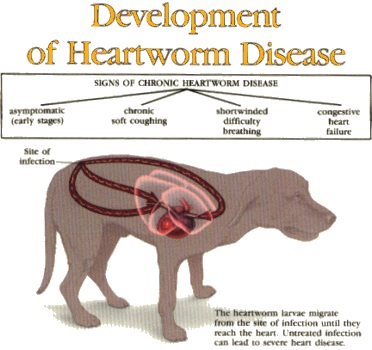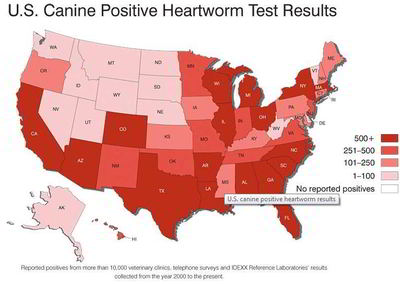Heartworm Infestation in Dogs

Heartworms are the most life-threatening canine worms, for they reside in the dog's heart and pulmonary arteries, causing heart failure and eventually death. Adult worms are 10 to 30 cm in length and about 1 mm in diameter.
Transmission and life cycle
Mosquitoes transmit heartworms. When an infected mosquito bites a dog, it passes him the worms’ larvae that start to migrate until they reach their final site (heart and pulmonary arteries) in about 3-4 months. Here, they grow to maturity within a further three months and start producing larvae which can survive for almost two years in the bloodstream.
When a mosquito bites an infected dog, it picks up these larvae and can transmit the infection to other dogs.
Disease
Over time, the presence of adult worms in the heart and pulmonary arteries causes inflammation and thickening of the blood vessels' walls, leading to increased blood pressure and the cardiac effort to push the blood in these vessels. As a consequence, the dog may develop heart failure, which can eventually lead him to death. When the disease has reached a very severe stage (usually 3 to 5 years from infection), clinical symptoms typically appear. First signs consist of sporadic coughing and tiredness; as time passes, the cough becomes chronic and is accompanied by difficult respiration, particularly during and after exercise. In advanced cases, the dog may collapse after even light physical exertion. Most dogs eventually develop congestive heart failure.
Treating Heartworm Infection
Treatment of heartworm infection is a long and risky process. Dying heartworms, as well as their larvae, may determine shock and embolism. The dogs must be strictly controlled for side effects during therapy, and their activity restricted for a few weeks. Moreover, in advanced cases, the dogs' health will not be restored even after effective treatment. For all these reasons, it is now clear why prevention is so important.
Heartworm Prevention
In contrast to therapy, most heartworm prevention is safe, easy, and effective. Before prophylactic treatment starts, dogs tested for heartworm infection found to be infected must be treated against adults and microfilariae before a prevention program starts. Preventatives are usually administered monthly, starting within one month from the beginning of the mosquito season (or the exposure to a possible infection, e.g., during travel to heartworm countries), until one month after the end of the exposure.
Some preventatives are also effective against all other typical dog worms, thus ensuring your pet's complete protection. Be careful using "complete protection" if your dog is sensitive to some of the ingredients. Also, note that a preventive that prevents everything is loading your pet with many toxic ingredients.




